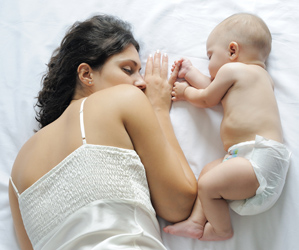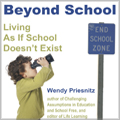Safe Co-Sleeping
by Judy Arnall
|

Photo © fdgfoto/Shutterstock
|
Your baby has been crying for hours in the middle of the night. Nothing will calm her. Finally, she settles in your arms but awakens and screams the minute you set her in her crib. Out of exhaustion, you take her into bed with you and both you and baby snuggle in for a cozy sleep.
Except for North America and some parts of Europe, most people in countries around the world sleep with their children. The trend is also increasing here, although many parents don’t like to admit to the practice. They worry about safety concerns and receive advice from friends and relatives that once their baby is in bed with them, they’ll never get her out, which is unsupported by research, by the way. But the reality is that most parents will sleep with their baby at some point in time, whether for a temporary period or as an on-going practice.
Many parents want the closeness and comfort of sharing a bed with their baby full time. Others do it for half the night while getting the baby to sleep, or getting more sleep during the early hours of the morning, or for nap times. Baby could be teething, sick, have night terrors, and need night-time parenting. Or they could be on holidays with no crib.
Benefits of Co-Sleeping
-
Parents and baby have close emotional and physical bonding time.
-
Mom gets more sleep, as she can attend to baby’s needs while both are still somewhat not fully awake. Mom and baby can get back to sleep faster.
-
Baby barely wakes to feed, but can easily attach to the breast, so she goes back to sleep faster.
-
Mom and baby’s breathing cycles adjusts to be in sync with each other. May offer SIDS (Sudden Infant Death Syndrome) protection by keeping baby’s breathing adjusted to mom’s and preventing deep sleep for babies where they may “forget” to breathe.
-
Dad has the ability to provide warmth and bonding time with baby, in order to give mom a break.
-
Touch between parent and baby is a necessary survival need.
-
Provides easier access for on-demand nursing.
-
Provides psychological and emotional health for baby in that they develop trust and security that their needs will be met anytime in the daytime or nighttime of the first year.
Myths About Co-Sleeping
-
Babies and children will find it so cozy that they may never leave the bed to go to sleep in their own bed. It’s true that babies and young children love to sleep with their parents. It makes them feel safe, secure, happy, contented, and loved. Some children have longer dependency needs than others and may stay until preschool- or school-aged. Other children are fiercely independent and may want to share a bed with siblings or sleep on their own. Research consistently shows that the sooner a child’s security needs are met, the faster they become independent, so it’s in the child’s and parent’s best interests to let the child decide when and where they will sleep alone.
-
Parents will never have sex. Many parents move the child to their own bed after they fall asleep and then have time and space to be romantic. Other parents choose the guest room or sofa to have sex; a variety of settings can add spice and excitement to the relationship.
-
Children can feel too psychologically powerful if they sleep with parents. There are no studies that show that co-sleeping does a baby or child any emotional or psychological harm.
Co-Sleeping Safety Tips
It’s important for parents to know that there are risks and benefits to co-sleeping just as there are risks and benefits to crib use. It is possible that baby could be suffocated or entrapped in the first year by Mom, Dad, siblings, pets, bedding, or surroundings.
How can parents make co-sleeping safer? An adult bed is just like an automobile; both are not custom made for infants. For cars, we have invented car seats to reduce the risk of injury and death while travelling. For beds, we have several safety recommendations to reduce the risk while sleeping together.
There are basically two ways to have a safer sleep-sharing experience. Some parents try the sidecar approach. They put the crib in the master bedroom with one crib side down. The lowered crib side is moved right next to the bed. This is called co-sleeping. Other parents just get rid of the box spring and put a king size mattress down on the floor so there is no danger of falling. Just as adults are aware of the edges of their beds and seldom fall off, mothers and babies become intuitively aware of each other as they sleep, so rolling over on baby is not common. This is called bed-sharing. The following tips can reduce the risks of suffocation, wedging, entrapment, and falling:
-
Never sleep with baby while under the influence of drugs, prescription drugs, over the counter drugs, and alcohol, or if partner is under the influence of the same.
-
Never leave baby unattended on an adult bed.
-
Keep pillows, comforters, stuffed animals, and sheets away from baby. Dress baby in a warm fleece sleeper and Mom in a warm cotton turtleneck so the upper body doesn’t get cold and you don’t need blankets or comforters to cover up.
-
Pin away any adult’s long hair and fasten it up.
-
Make sure sheets are fitted under the mattress.
-
Always put the baby on her back to sleep.
-
Avoid siblings in the same bed. If siblings do share a bed, Mom should sleep between sibs and the baby.
-
If using a bed with legs, make sure the spacing between headboard and footboard is no more than currently allowed for mattress-crib spacing in safety approved cribs.
-
If mom or dad smoked during the pregnancy, avoid bed-sharing.
-
The mattress must be firm.
-
Never co-sleep on couches, overstuffed chairs or sofas, waterbeds, or hide-a-beds.
-
Never cover up your baby’s face.
-
The mattress should not be against a wall or furniture because the baby could become entrapped.
-
Baby should not sleep between Mom and Dad due to overheating produced from both bodies. Sleeping between Mom and the end of mattress on the floor is the safest. Many countries where sleep sharing is common, only have Mom and her baby bed share, not Dad, siblings, or pets.
-
Avoid strings and ties on both baby’s and parent’s nightclothes.
-
Avoid overheating the room and the baby.
-
Avoid sleeping near window treatment cords that could strangle, or windows that could pose a falling risk.
-
Avoid using bed rails for infants under one year.
No infant sleep environment is one hundred percent safe. But by following the safety recommendations for cribs or co-sleeping, we can greatly reduce the risks of suffocation. After the age of one year, there are no safety concerns and where children sleep is a personal matter of family preferences.
No health professional should tell parents where their child should sleep because research supports that children thrive physically and emotionally in all sleeping environments where no one is crying and everyone is sleeping safely.
Judy Arnall is a professional parenting speaker and trainer, mom of five children, and author of the best-selling, “Discipline Without Distress: 135 tools for raising caring, responsible children without time-out, spanking, punishment or bribery.” She specializes in “Parenting the Digital Generation.” Contact her through her website www.professionalparenting.ca.
|
|







